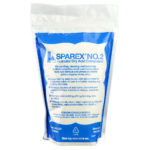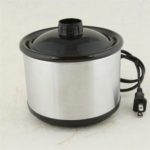When I say pickle, what is the first thing that springs to mind? Lovely, crunchy dills and onions or a crockpot of simmering sodium bisulfate? If it’s the latter, you are most certainly a jeweller! Even if it’s not your first choice, you could still be a jeweller who also enjoys tasty treats. (Just don’t mix them up!)
Pickling is one of those things we do in jewellery making that we may not think a lot about. Flux, solder, pickle, rinse, etc, etc, etc. But, what is pickle really? And, why do we use it?
Commercial pickle is a mild acid called soldium bisulphate. It is used pre-soldering to ensure the metal is clean and post-soldering to remove flux and oxidation. Pickle will NOT remove firescale (sometimes also called firestain)! That requires physical removal by filing, buffing, or plating – a subject for another day.
There are several different substances that can be used as pickle. The commercial product, Sparex#2 is popular and works well.

You can also use a spa chemical called PhDown, which is sodium bisulfate – the same chemical as Sparex#2. This “dry acid” when mixed with water becomes a dilute sulfuric acid. Pickle works best when used warm. A crock-pot makes a perfect pickle pot, just remember to turn it off when you are not using it. When warm, there will be some steam rising from the pot, so keep the lid on it and don’t breath in the fumes, when placing pieces in and out of the pickle solution. Always work in a well ventilated area when soldering and pickling. 
When the pickle solution becomes blue/green, when you open your pickle pot lid and it’s just crystals in the bottom of the pot, or when it stops cleaning your silver well, it’s time to change your pickle solution. When changing the pickle solution, you will need to neutralize the acid with baking soda (in a VERY well ventilated area), then (if you can) also remove the copper before pouring what’s left of your solution down the sink drain. See our blog on disposing of your pickle in a safe, environmentally friendly manner, HERE.

Some people are choosing to use common household products to make their own non-toxic pickle. Two or three tablespoons of citric acid in distilled water can be used, or vinegar and two teaspoons salt will also work. These solutions are also used warm and do not work nearly as fast as sodium bisulfate solutions. Please note that even though you do not need to neutralize these home made solutions, it’s still best to remove the copper from the liquid before disposing of it.
If you live in an area where the water is “hard”, with high mineral and/or metal content, use distilled water for your pickle. Minerals and metals in tap water can react with the acid and cause some unpleasant reactions. We spoke with a customer recently who mixed up a batch of pickle with tap water, and her silver pieces came out of her pickle grey and icky. She lives in an area where the water is “hard”, and she had been using distilled water until then. In the Greater Vancouver area, we are fortunate to have “soft” water, so we don’t need to use distilled water for our pickle solutions. Also, make sure to add the acid to the water and not the other way around otherwise you may get a rather exciting chemical reaction! Adding the acid to the water keeps the solution diluted and unlikely to sputter.
Copper tongs are an absolute necessity for holding metal going into and out of the pickle. Ferrous metals (like steel tweezers or binding wire!) will react with the pickle and cause copper electroplating (copper flashing) on your pieces. You definitely do NOT want to copper plate your sterling silver pieces! There are times when you may want to copper plate using pickle, like when you’ve soldered copper and you want to plate the piece to cover the solder join. See our Blog on Copper Plating to see what we’re referring to HERE.

There is a way to remove copper electroplating (copper flashing). In a well ventilated area, mix one part pickle acid to one part hydrogen peroxide and put your piece in for a few minutes. This will remove the copper plating from your piece like magic!!! (see again the risk of copper electroplating).
When in the studio, whether working with hand or power tools, or soldering, always wear eye protection, keep all hair tied back, wear a cotton apron, and full shoes. Being safe in the studio is a beautiful thing! See our blog on safety in the studio HERE.
Stay safe and have fun creating!!
